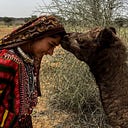TANG — Self-expression through a dwindling 700-year-old craft
A braided belt from the camel herders of Kachchh
By Bhavesh Rabari, Source: Kaarigar Ki Kahani
In present times, the region of Kachchh has 960 villages with more than 20 lakh inhabitants. Groups of people from Sindh, Balochistan, UP, Bihar, and Rajasthan migrated to Kachchh in different decades and for varied reasons, making it their homeland. The geological diversity of the land makes it suitable for pastoralism and many communities continue to be agriculturalists and pastoralists, like the Rabaris.
Traditionally, the source of income for a Rabari was through selling camel milk, sheep wool, and/or the animals themselves. Twenty years ago, camels used to be sold at fairs in Bikaner, Rajasthan. The trade is fast declining due to climate change, painstaking effort, lesser demand, and changes in lifestyle. Only 20% of the families in the Dhebaria subgroup’s 65 villages are pastoralists today.
As a pastoral’s work demanded travelling long distances, a wooden frame, called a Kathu, was fitted on the camel’s hump to provide support to the rider. It was tied to the camel with a ply-split braided belt called Tang. Tang, a Rabari camel belt, is a 700-year-old craft that has grown organically over the years through knowledge exchange within the community. Nomadic pastoralists spent much of their year in forests. Thus, the motifs of Tang also evolved with what the makers saw in their surroundings.
Commonly found motifs are camels, panihari (women with water pots on their heads), and scorpions. Scorpions hold a special position in Rabari culture. It is believed that a scorpion is an avatar taken by Lord Krishna, and it protects them during their time in the forest. Tattoos of a scorpion on the finger are also a very popular practice amongst the Rabaris. It should be noted that all Tang motifs are made in a 90-degree angle and look exactly the same from both sides.
Pachan bhai Rabari is one of the few practising ply-split weavers. He was born in the village of Kuday. Pachan bhai, his wife Sajnuben, two daughters, and one son live together now in Kukadsar. Hailing from the Dhebaria subgroup, the craft is his family tradition and his father taught him the skill.
He, like other Rabaris, was herding camels and sheep to earn his livelihood. In 2015, due to some personal crisis, he could not continue herding and took a job as a gardener for a multinational company. He sold his animals and now farms for the family on a small plot of land along with his job. As a pastoralist, he travelled on foot to Haryana and Chhattisgarh to feed his animals.
The factory where Pachan bhai worked shut down in the last few months, leaving him ample time to pick up the craft again.
He believes that art can help people build their own identities and gain recognition in the world. The craft of ply-split weaving was used to decorate the camels for festive occasions. Now, only museums can attest to the decoration of camels, as the practice has been completely stopped in the community. As many Hindu communities do not wear leather while praying in the temples, a tang belt called Chiliyo, was in high demand by the regular temple goers. Unlike modern belts with metal buckles, Chiliyo, a belt made of ply-split braiding has an inbuilt lock system. With a hole on one end and an extruding bulge on the other, it can lock itself without any external material.
The threads for the belt are prepared by spinning two different yarns together. Balls of the 2 ply thread are prepared and made ready for braiding. Made out of goat wool, Tang is originally in black and white, which are natural colours. Today, Pachan Bhai gets his threads directly from the market. A few new product ideas that Pachan Bhai has been working on are belts, guitar straps, and bags. He has very recently customised a belt with his name and date on it.
Only the elders practise the craft of ply-split weaving, as it is time-consuming; very few young pastoralists have the skill to make the same. As the practice among the Rabaris declined, it was picked up by other communities. There are still only a handful of artisans from other communities too who have the skill to make a fine Tang Belt.
